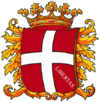Como
| Como | |||
|---|---|---|---|
| Comune | |||
| Città di Como | |||
|
View from Lake Como. The tower which tops the hill on the right is the Castello Baradello. | |||
| |||
 Como Location of Como in Italy | |||
| Coordinates: 45°49′0″N 9°5′0″E / 45.81667°N 9.08333°ECoordinates: 45°49′0″N 9°5′0″E / 45.81667°N 9.08333°E | |||
| Country | Italy | ||
| Region | Lombardy | ||
| Province / Metropolitan city | Como (CO) | ||
| Roman foundation | 196 BC | ||
| Frazioni | Albate, Breccia, Camerlata, Camnago Volta, Civiglio, Garzola, Lora, Monte Olimpino, Muggiò, Ponte Chiasso, Prestino, Rebbio, Sagnino, Tavernola | ||
| Government | |||
| • Mayor | Mario Lucini (PD) | ||
| Area | |||
| • Total | 37.34 km2 (14.42 sq mi) | ||
| Elevation | 201 m (659 ft) | ||
| Population (30 April 2015)[1] | |||
| • Total | 84,394 | ||
| • Density | 2,300/km2 (5,900/sq mi) | ||
| Demonym(s) | Comaschi | ||
| Time zone | CET (UTC+1) | ||
| • Summer (DST) | CEST (UTC+2) | ||
| Postal code | 22100 | ||
| Dialing code | 031 | ||
| Patron saint | Saint Abbondio | ||
| Saint day | 31 August | ||
| Website | Official website | ||

Como (Italian pronunciation: [ˈkɔːmo],[2][3] locally: [ˈkoːmo];[2] Lombard: Còmm [ˈkɔmː],[4] Cómm [ˈkomː] or Cùmm [ˈkumː];[5] Latin: Novum Comum) is a city and comune in Lombardy, Italy. It is the administrative capital of the Province of Como.
Its proximity to Lake Como and to the Alps has made Como a tourist destination and the city contains numerous works of art, churches, gardens, museums, theatres, parks and palaces: the Duomo (seat of Diocese of Como), the Basilica of Sant'Abbondio, the Villa Olmo, the public gardens with the Tempio Voltiano, the Teatro Sociale, the Broletto (the city's medieval town hall) and the 20th century Casa del Fascio.
With 215,320 arrivals, in 2013 Como was the fourth most visited city in Lombardy after Milan, Bergamo and Brescia.[6]
Como was the birthplace of many historical figures, including the poet Caecilius mentioned by Catullus in the 1st century BCE,[7] writers Pliny the Elder and the Younger, Pope Innocent XI, scientist Alessandro Volta,[8] and Cosima Liszt, second wife of Richard Wagner and long-term director of the Bayreuth Festival.
History

The hills surrounding the current location of Como have been inhabited, since at least the Bronze Age, by a Celtic tribe known as the Orobii. Remains of settlements are still present on the wood covered hills to the South West of town.
Around the 1st century BC, the territory became subject to the Romans. The town center was situated on the nearby hills, but it was then moved to its current location by order of Julius Caesar, who had the swamp near the southern tip of the lake drained and laid the plan of the walled city in the typical Roman grid of perpendicular streets. The newly founded town was named Novum Comum and had the status of municipium.
In 774, the town surrendered to invading Franks led by Charlemagne, and became a center of commercial exchange.
In 1127, Como lost a decade-long war with the nearby town of Milan. A few decades later, with the help of Frederick Barbarossa, the Comaschi were able to avenge their defeat when Milan was destroyed in 1162. Frederick promoted the construction of several defensive towers around the city limits, of which only one, the Baradello, remains.
Subsequently, the history of Como followed that of the Ducato di Milano, through the French invasion and the Spanish domination, until 1714, when the territory was taken by the Austrians. Napoleon descended into Lombardy in 1796 and ruled it until 1815, when the Austrian rule was resumed after the Congress of Vienna. Finally in 1859, with the arrival of Giuseppe Garibaldi, the town was freed from the Austrians and it became part of the newly formed Kingdom of Italy under the House of Savoy.
At the end of World War II, after passing through Como on his escape towards Switzerland, Benito Mussolini was taken prisoner and then shot by partisans in Giulino di Mezzegra, a small town on the north shores of Lake Como.
In 2010, a motion by members of the nationalist Swiss People's Party (SVP) has been submitted to the Swiss parliament requesting the admission of adjacent territories to the Swiss Confederation; Como (and its province) is one of these.[9][10][11]
As a curiosity, the Rockefeller fountain that today stands in the Bronx Zoo in New York City was once in the main square (Piazza Cavour) by the lakeside. It was bought by William Rockefeller in 1902 for 3,500 lire (the estimated equivalent then of $637).[12]
Geography
Situated at the southern tip of the south-west arm of Lake Como, is located 40 kilometres (25 mi) north of Milan; the city proper borders Switzerland and the communes of Blevio, Brunate, Capiago Intimiano, Casnate con Bernate, Cavallasca, Cernobbio, Grandate, Lipomo, Maslianico, Montano Lucino, San Fermo della Battaglia, Senna Comasco, Tavernerio, Torno and the Swiss towns of Chiasso and Vacallo. Nearby major cities are Varese, Lecco and Lugano.
Administrative subdivisions
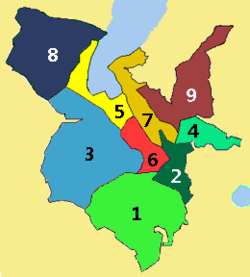
Como is divided into the following frazioni (roughly equivalent to the anglocentric ward):
- 1 – Albate – Muggio' – Acquanera
- 2 – Lora
- 3 – Prestino – Camerlata – Breccia – Rebbio
- 4 – Camnago Volta
- 5 – City Center – West Como
- 6 – Borghi
- 7 – North Como – East Como
- 8 – Monte Olimpino – Ponte Chiasso – Sagnino – Tavernola
- 9 – Garzola – Civiglio
Climate
According to the Köppen climate classification, Como has a humid subtropical climate (Cfa); winters are not long, but foggy, damp and chilly with occasional periods of frost from the siberian anticyclone; spring and autumn are well marked and pleasant, while summer can be quite oppressive, hot and humid. Wind is quite rare; only sudden bursts of foehn or thunderstorms manage to sweep the air clean.
Pollution levels rise significantly in winter when cold air clings to the soil. Rain is more frequent during spring; summer is subject to thunderstorms and, occasionally, violent hailstorms.
| Climate data for Como, Italy | |||||||||||||
|---|---|---|---|---|---|---|---|---|---|---|---|---|---|
| Month | Jan | Feb | Mar | Apr | May | Jun | Jul | Aug | Sep | Oct | Nov | Dec | Year |
| Average high °C (°F) | 6 (43) |
8 (47) |
13 (56) |
17 (63) |
23 (73) |
26.5 (79.7) |
30 (86) |
28.3 (82.94) |
23 (74) |
19 (66) |
12 (53) |
9 (48) |
19 (67) |
| Daily mean °C (°F) | 2 (36) |
4 (39) |
7 (45) |
12 (53) |
17 (63) |
21.4 (70.5) |
24.5 (76.1) |
23.6 (74.4) |
17 (63) |
12 (54) |
8 (46) |
4 (40) |
13 (56) |
| Average low °C (°F) | −2 (28) |
−1 (30) |
4 (39) |
7 (45) |
12 (54) |
16 (61) |
19 (66.2) |
19 (66) |
13 (56) |
9 (48) |
4 (40) |
2 (35) |
8 (47) |
| Average precipitation mm (inches) | 52 (2.05) |
35 (1.38) |
47 (1.85) |
110 (4.33) |
128 (5.04) |
134 (5.28) |
98 (3.86) |
97 (3.82) |
105 (4.13) |
121 (4.76) |
99 (3.9) |
46 (1.81) |
1,072 (42.2) |
| Average relative humidity (%) | 84 | 76 | 69 | 74 | 72 | 71 | 73 | 72 | 74 | 81 | 85 | 86 | 76 |
| Mean monthly sunshine hours | 59 | 97 | 151 | 176 | 209 | 242 | 285 | 253 | 187 | 129 | 65 | 58 | 1,911 |
| Source: [13][14][15][16] | |||||||||||||
Main sights
Churches
- Como Cathedral: construction began in 1396 on the site of the previous Romanesque church of Santa Maria Maggiore. The façade was built in 1457, with the characteristic rose window and a portal flanked by two Renaissance statues of the famous comaschi Pliny the Elder and Pliny the Younger. The construction was finished in 1740. The interior is on the Latin cross plan, with Gothic nave and two aisles divided by piers, while the transept wing and the relative apses are from the Renaissance age. It includes a carved 16th century choir and tapestries on cartoons by Giuseppe Arcimboldi. The dome is a rococo structure by Filippo Juvarra. Other artworks include 16th–17th century tapestries and 16th century paintings by Bernardino Luini and Gaudenzio Ferrari.
- San Fedele, a Romanesque church erected around 1120 over a pre-existing central plan edifice. The original bell tower was rebuilt in modern times. The main feature is the famous Door of St. Fedele, carved with medieval decorations.
- Sant'Agostino, built by the Cistercians in the early 14th century, heavily renovated in the 20th. The interior and adjoining cloister have 15th–17th century frescoes, but most of the decoration is Baroque.
- The Romanesque basilica of Sant'Abbondio, consecrated in 1095 by Pope Urban II. The interior, with a nave and four aisles, contains paintings dating to the 11th century and frescoes from the 14th.
- San Carpoforo (11th century, apse and crypt from 12th century). According to tradition, it was founded re-using a former temple of the God Mercury to house the remains of Saint Carpophorus and other local martyrs.
Secular buildings and monuments
- The ancient town hall, known as the Broletto
- Casa del Fascio, possibly Giuseppe Terragni's most famous work. It has been described as an early "landmark of modern European architecture".
- Monumento ai caduti (war memorial) by Giuseppe Terragni
- Teatro Sociale by Giuseppe Cusi in 1813[17]
- Villa Olmo, built from 1797 in neoclassicist style by the Odescalchi family. It housed Napoleon, Ugo Foscolo, Prince Metternich, Archduke Franz Ferdinand I, Giuseppe Garibaldi, and other eminent figures. It is now seat of exhibitions.
- Monumental Fountain also known as Volta's Fountain, is a monument to Volta's battery; it was designed by architect Carlo Cattaneo and painter Mario Radice and is a 9 m high cement combination of alternating spheres and rings. It is in the center of Camerlata square.
- Ancient walls (medieval).
- the Life Electric, a modern sculpture made by Daniel Libeskind.
- Castello Baradello, a small medieval castle overlooking the town and which is all that remains of the fortress constructed by Barbarossa c. 1158.
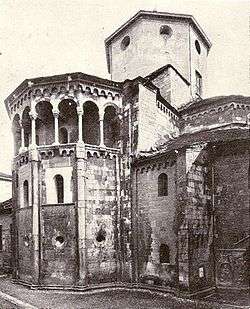
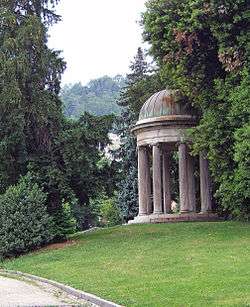
Economy
The economy of Como, until the end of the 1980s, was traditionally based on industry; in particular, the city was world-famous for its silk manufacturers,[18] but in recent years cheap competition from China has significantly reduced profit margins and many small and mid-sized firms have gone out of business. As a consequence manufacturing is no longer the economic driver and the city has been absorbed into Milan's metropolitan area where it mainly provides workers to the service industry sector. A significant number of residents is employed in the nearby industrial areas of the Swiss towns of Lugano and Mendrisio, primarily in the industrial sector, health care services and in the hospitality industry; the 30 km (19 mi) commute is beneficial as wages in Switzerland are notably higher. For these reasons, tourism has become increasingly important for the local economy since the 1990s. The city and the lake have been chosen as the filming location for various recent popular feature films, and this, together with the increasing presence of celebrities who have bought lakeside properties, has heightened the city's international profile and given a further boost to international tourism.
Demographics
The city of Como has seen its population count increase until it peaked at almost 100,000 inhabitants in the 1970s, when manufacturing, especially the silk industry, was in its boom years. As production began to decline, the population decreased by almost 20,000 people until the start of the 21st century, when the city saw its population grow again by more than six thousand, mainly because of immigration from Asia, Eastern Europe and North Africa. As at 31 December 2010, there were 11,156 resident aliens living in the city, that is, 13% of the total; the population distribution by origin was as follows:[19]
| Pos. | Continent | Percentage |
|---|---|---|
| 1 | Europe | 5.3% |
| 2 | Asia | 3.5% |
| 3 | Africa | 2.5% |
| 4 | Americas | 1.6% |
| 5 | Oceania | 0.1% |
The top 40 nationalities were:
| Pos. | Citizenship | Residents |
|---|---|---|
| 1 | | 1237 |
| 2 | | 1076 |
| 3 | | 1020 |
| 3 | | 832 |
| 5 | | 684 |
| 6 | | 664 |
| 7 | | 478 |
| 8 | | 448 |
| 9 | | 421 |
| 10 | | 384 |
| 11 | | 323 |
| 12 | | 262 |
| 13 | | 203 |
| 14 | | 199 |
| 15 | | 155 |
| 16 | | 110 |
| 17 | | 109 |
| 18 | | 104 |
| 19 | | 101 |
| 20 | | 101 |
| 21 | | 98 |
| 22 | | 91 |
| 23 | | 90 |
| 24 | | 87 |
| 25 | | 79 |
| 26 | | 79 |
| 27 | | 73 |
| 28 | | 68 |
| 29 | | 65 |
| 30 | | 60 |
| 31 | | 58 |
| 32 | | 50 |
| 33 | | 48 |
| 34 | | 47 |
| 35 | | 45 |
| 36 | | 41 |
| 37 | | 37 |
| 38 | | 34 |
| 39 | | 33 |
Culture
Museums
In Como there are the following museums and exhibition centers:
- Museo Archeologico "P. Giovio" – Archeological museum
- Museo Storico "Garibaldi" – a museum dedicated to Giuseppe Garibaldi
- Tempio Voltiano – a museum devoted to Alessandro Volta's work.
- Villa Olmo – various exhibitions
- Museo Didattico Della Seta – Educational Silk Museum
- Museo Liceo classico "A. Volta" – Scientific Museum
- Pinacoteca Civica – Paintings
Cuisine
Polenta is a popular dish in Como, and was traditionally eaten for meals in winter time. It is obtained by mixing and cooking corn flour and buckwheat. It is usually served with meat, game, cheese and sometimes fish; in fact, Polenta e Misultin (Alosa agone) is served in the restaurants in the Lake Como area.
A traditional dish is the Risotto con Filetti di Pesce Persico or simply Risotto al Pesce Persico (European Perch filet Risotto), a fish grown in Lake Como, prepared with white wine, onion, butter and wheat.[20]
Transportation
Rail
The Servizio Ferroviario Regionale (Regional Railway Service) connects Como by train to other major cities in Lombardy. Services are provided by Trenord through two main stations: Como San Giovanni and Como Lago. There are five more urban stations (Albate-Camerlata, Albate-Trecallo, Como Borghi, Como Camerlata and Grandate-Breccia).
Como San Giovanni is also a stop on the main North-South line between Milan Centrale and Zürich and Basel. Intercity and Eurostar trains stop at this station, which makes Como very accessible from the European express train network.
The Como to Brunate funicular connects the center of Como with Brunate, a small village (1,800 inhabitants) on a mountain at 715 m (2,346 ft) above sea level.
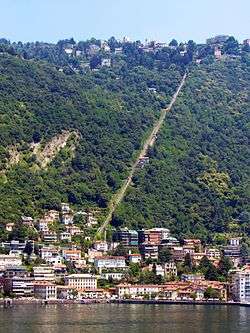
Buses and taxis
The local public transport network comprises 11 urban (within city limits) lines and 'extra-urban' (crossing city limits) (C) lines connecting Como with most of its province centers. They are provided by ASF Autolinee.
Ferrovie Nord Milano also provides other bus lines connecting Como to Varese in substitution of the original railway line that was dismissed in the 1960s.
A taxi service is provided by the Municipality of Como.
Ship transport
The boats and hydrofoils (aliscafi) of Navigazione Lago di Como connect the town with most of the villages sitting on the shores of the lake.
Airports
Nearby airports providing scheduled flights are Milano Malpensa, Milano Linate, Lugano Agno (in Switzerland) and Orio al Serio Airport near Bergamo. Milano Malpensa can be reached in about half an hour by car; about two hours by train to Stazione Centrale (Milano Central) and then direct shuttle coach[21] or about an hour and a half by train (interchange in Saronno);[22] Milano Linate can be reached by car in about an hour, or by train to Stazione Centrale and then local tram.
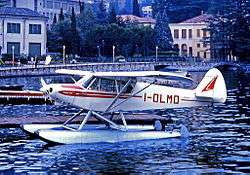
Bergamo's Orio al Serio Airport can be reached in about an hour and a quarter by car; in two hours by train to Milano Central and then half-hourly shuttle coach. Lugano Agno can be reached by car in less than an hour or by train in an hour and a half (changing once and walking) but it only offers direct flights to Switzerland and Italy[23] and generally higher-priced business class or private charter.
Trains from Como to Zürich Airport take three to five hours.[24]
Como also has an "international" water aerodrome ("Idroscalo", ICAO code LILY)[25] and seaplane base, which hosts its own aeroplane club with a fleet of sea planes, used for flight training and local tour flights.[26] A hangar is available for aircraft maintenance and servicing.
Education and health
Como is home to numerous high schools, the Conservatory of music "G. Verdi", a language school, the University of Insubria and a branch campus of the Politecnico di Milano.
In Como there are three major hospitals: Ospedale Sant'Anna, Ospedale Valduce and Clinica Villa Aprica
Sports
Notable sports clubs are a basketball team, two time winner of the FIBA EuroLeague Women, and Calcio Como, a football team. There are also numerous recreational activities available for tourists such as pedal-boating, fishing, walking and seaplane rentals.
People
Born in Como
People born or raised in Como include:
- Pliny the Elder (Gaius Plinius Secundus; 23–79 CE), author, natural philosopher and naval and military commander known for the Naturalis Historia.
- Caecilius c. 59 CE. A poet, the subject of Catullus's Carmina 35,[27] who had a girlfriend more learned than the Sapphic Muse.[7][28]
- Pliny the Younger (Gaius Plinius Caecilius Secundus; 63–c.113 CE), lawyer, an author and a natural philosopher of Ancient Rome.
- Paolo Giovio (1483–1552), physician, historian and biographer remembered as a chronicler of the Italian Wars.
- Benedetto Odescalchi (1611–1689) was Pope Innocent XI from 1676 until his death.
- Alessandro Volta (1745–1827), physicist known for the development of the battery in 1800.
- Luigi Borgomainerio (1836–1876), caricaturist.
- Cosima Liszt (1837–1930), Franz Liszt's daughter and Richard Wagner's wife.
- Antonio Sant'Elia (1888–1916), architect.
- Mario Radice (1898–1987), abstract painter.
- Maria Roda (1877-?), Italian American anarchist-feminist
- Manlio Rho (1901–1957), abstract painter.
- Carla Porta Musa (1902–2012), essayist, poet and unverified supercentenarian.
- Giuseppe Terragni (1904–1943), an architect and pioneer of the Italian modern movement and rationalism.
- Giorgio Perlasca (1910–1992), saved 5218 Jews from transportation to Nazi Germany and the Holocaust.
- Antonio Spallino (born 1925), Olympic fencer and mayor of Como from 1970 to 1985
- Gabriele Oriali (born 1952), 1982 Italian national team footballer World Champion.
- Corrado Passera (born 1954), manager and banker, Minister of Economic Development of the Monti Cabinet
- Stefano Casiraghi (1960-1990) World Offshore Champion and second husband of Caroline Princess of Monaco
- Max Papis (born 1969), Formula One, Champ Car, and NASCAR racing driver
- Luisa Lambri (1969), artist, photographer, filmmaker
- Fabio Casartelli (1970–1995) cyclist and olympic gold medalist.
- Diego De Ascentis (born 1976), football midfielder.
- Paola Tagliabue (born 1976), world champion free diver in 2006.
- Gianluca Zambrotta (born 1977), international footballer and World Champion in Germany 2006.
- Floraleda Sacchi (born 1978), harpist and musicologist.
- Anna Cappellini (born 1987), ice dancer, olympian, two times national champion, European champion and world champion in 2014.
- Francesca Rio (born 1990), figure skater, junior national champion and 3 times national silver medalist.
- Matteo Bianchetti (born 1993), captain of the Italian national under-21 football team
- Agostina Camozzi (1435 - 1458), Roman Catholic professed religious from the Order of Saint Augustine beatified by Pope Gregory XVI on 19 September 1834.
International celebrities
These celebrities have lived in or owned properties in Como or on its lake:
- George Clooney – American actor
- Madonna – American pop singer
- Gianni Versace – Italian fashion designer
- Matt Bellamy – lead singer and guitar player of English rock band Muse
- Ben Spies – American professional motorcycle racer
International relations
 Fulda, Germany, since 1960
Fulda, Germany, since 1960 Tokamachi, Japan, since 1975
Tokamachi, Japan, since 1975 Nablus, Palestine, since 1998
Nablus, Palestine, since 1998 Netanya, Israel, since 2004[30]
Netanya, Israel, since 2004[30]
See also
Notes
- ↑ "Demo-Geodemo. - Maps, Population, Demography of ISTAT - Italian Institute of Statistics". Retrieved 13 June 2016.
- 1 2 Migliorini, Bruno; Tagliavini, Carlo; Fiorelli, Piero. Tommaso Francesco Borri, ed. "Dizionario italiano multimediale e multilingue d'ortografia e di pronunzia". dizionario.rai.it. Rai Eri. Retrieved 12 February 2016.
- ↑ Canepari, Luciano. "Dizionario di pronuncia italiana online". dipionline.it. Retrieved 12 February 2016.
- ↑ Carlo Bassi, Grammatica essenziale del «dialètt de Còmm», Como, Edizioni della Famiglia Comasca, 2014
- ↑ Libero Locatelli, Piccola grammatica del dialetto comasco, Como, Famiglia Comasca, 1970, p. 6.
- ↑ "RSY Lombardia-Arrivals and nights spent by guests in accommodation establishments, by type of resort and by type of establishment. Total accommodation establishments. Part III. Tourist resort. Year 2013". asr-lombardia.it. Retrieved 31 May 2015.
- 1 2 John Hazel (2001). Who's who in the Roman World. Psychology Press. p. 42. ISBN 978-0-415-22410-9.
- ↑ "Alessandro Volta". Corrosion-doctors.org. Retrieved 2011-06-21.
- ↑ Maurisse, Marie (22 June 2010). "Quand un député suisse rêve d'annexer la Savoie". Le Figaro. Retrieved 22 June 2010.
- ↑ "SVP-Forderung: Vorarlberg soll Kanton werden". Der Standard. 21 June 2010. Retrieved 22 June 2010.
- ↑ Coen, Leonardo (22 June 2010). "L'ultima tentazione di Como: "Vogliamo diventare svizzeri"". La Repubblica. Retrieved 22 June 2010.
- ↑ "Bronx Park Highlights". Retrieved 18 January 2011.
- ↑ "Monthly Averages for Como, Italy". The Weather Channel. Retrieved 14 July 2010.
- ↑ "Monthly Averages for Como, Italy". MSN Weather. Retrieved 14 July 2010.
- ↑ "Weather in Como, Italy". Retrieved 14 July 2010.
- ↑ "Como climate averages". Weatherbase. Retrieved 30 June 2016.
- ↑ Il tetatro socilae di Come (in English)
- ↑ Tagliabue, John (10 April 1997). "Italian Silk Industry Upset By a New U.S. Trade Law". The New York Times. Retrieved 18 July 2010.
- ↑ "Cittadini Stranieri (Foreigners)". Comuni Italiani. Retrieved 20 August 2012.
- ↑ "Food and Culture Encyclopedia:Northern Italy". answers.com. Retrieved 5 April 2010.
- ↑ Malpensa Shuttle
- ↑ "Le Nord". Retrieved 20 September 2014.
- ↑ "SkyScanner". Retrieved 20 September 2014.
- ↑ "Swiss Railways". Retrieved 20 September 2014.
- ↑ AIP Italia AD2 LILY
- ↑ "Aero Club Como". Retrieved 20 September 2014.
- ↑ Carmina (Catullus)/35
- ↑ http://www.let.ru.nl/v.hunink/documents/catullus_md.htm
- ↑ "Città Gemellate". Comune di Como. Retrieved 20 August 2012.
- ↑ "Netanya - Twin Cities". Netanya Municipality. Archived from the original on 2013-02-01. Retrieved 2013-08-01.
Sources
- "Como". Northern Italy (14th ed.). Leipzig: Karl Baedeker. 1913. OpenLibrary
External links
| Wikimedia Commons has media related to Como. |
| Wikivoyage has a travel guide for Como. |
- Official website (Italian) (English)
- Official Tourism Portal
- Historical picture gallery and slideshow
- Official Tourist Board website (Italian) (English)
- Lake Como Navigation Company
- Official Virtual Tour
- A documentary about the Lake by Yann Arthus-Bertrand

